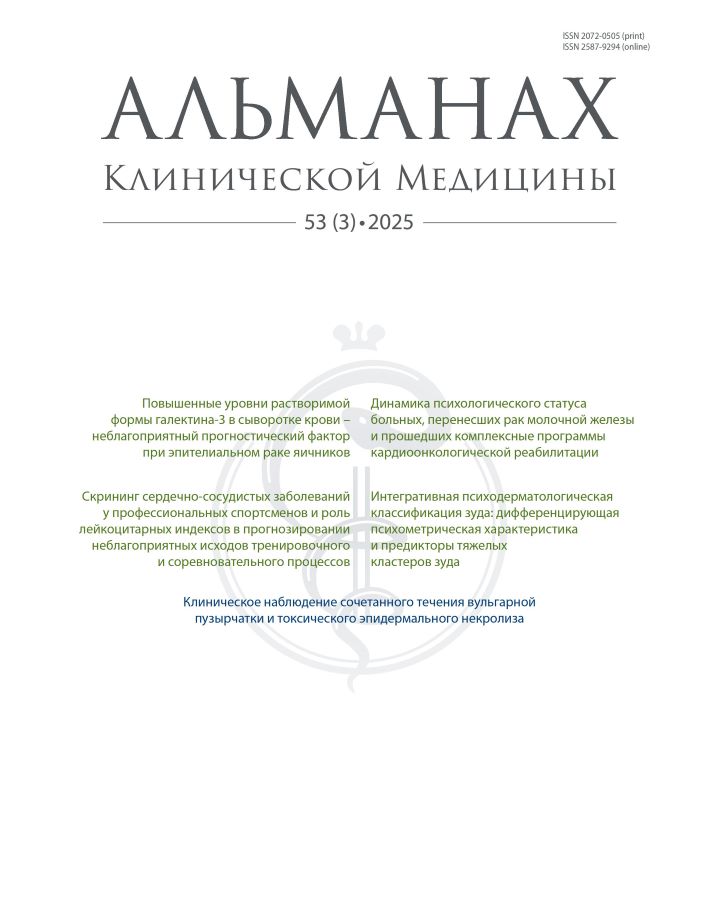Эпидемиология увеальной меланомы в г. Москве
- Авторы: Гришина Е.Е.1, Лернер М.Ю.2, Гемджян Э.Г.3
-
Учреждения:
- ГБУЗ МО «Московский областной научно-исследовательский клинический институт им. М.Ф. Владимирского»
- Филиал № 1 ГБУЗ г. Москвы «Городская клиническая больница имени С.П. Боткина» ДЗ г. Москвы
- ФГБУ «Гематологический научный центр» Минздрава России
- Выпуск: Том 45, № 4 (2017)
- Страницы: 321-325
- Раздел: ОРИГИНАЛЬНЫЕ СТАТЬИ
- Дата публикации: 15.06.2017
- URL: https://almclinmed.ru/jour/article/view/564
- DOI: https://doi.org/10.18786/2072-0505-2017-45-4-321-325
- ID: 564
Цитировать
Полный текст
Аннотация
Актуальность. Меланома увеального тракта глаза относится к наиболее часто встречающимся злокачественным внутриглазным опухолям.
Цель – выявить эпидемиологические особенности увеальной меланомы в г. Москве.
Материал и методы. Ретроспективно проанализированы данные амбулаторных карт и форм диспансерного наблюдения больных увеальной меланомой в Офтальмологической клинической больнице Департамента Здравоохранения г. Москвы за период с 1977 по 2012 г.
Результаты. За 36 лет было зарегистрировано 2547 больных увеальной меланомой в возрасте от 16 до 92 лет. Соотношение мужчин и женщин составило 1:1,5. Частота обращения пациентов, которым была диагностирована увеальная меланома, за период 1977–2000 гг. не изменялась и в среднем была 1,07 человек на 100 тыс. взрослого населения. С 2001 по 2012 г. отмечается некоторое уменьшение обращаемости по увеальной меланоме: в среднем 0,9 человек на 100 тыс. взрослого населения. Выполнен анализ выживаемости 359 пациентов, которым по поводу увеальной меланомы была произведена энуклеация пораженного глаза, из них мужчин было 37% (63,2 ± 1,8 года), женщин – 63% (69,5 ± 2,7 года). Пятилетняя специфическая выживаемость составила 65 ± 3%, семилетняя – 60 ± 4%. Среднее время до летального исхода 5,5 года. Зависимости продолжительности жизни больных от пола не выявлено. Определена связь выживаемости с возрастом больных. Риск летального исхода от метастазов у больных увеальной меланомой старше 60 лет увеличивался в среднем на 10%. После энуклеации продолжительность жизни больных меланомой в стадии Т4 по сравнению со стадиями Т1-3 была статистически значимо ниже: 5 и 6,5 года соответственно (р = 0,05).
Заключение. Частота выявления увеальной меланомы по обращаемости за 36-летний период не увеличилась. Эпидемиология увеальной меланомы в г. Москве характеризуется большой долей женщин старших возрастных групп. На уменьшение общей и специфической выживаемости больных увеальной меланомой после энуклеации влияет увеличение доли пожилых людей в региональной популяции и поздние сроки выявления заболевания.
Ключевые слова
Об авторах
Е. Е. Гришина
ГБУЗ МО «Московский областной научно-исследовательский клинический институт им. М.Ф. Владимирского»
Автор, ответственный за переписку.
Email: eyelena@mail.ru
д-р мед. наук, профессор, вед. науч. сотр. офтальмологического отделения
129110, г. Москва, ул. Щепкина, 61/2–11, Российская Федерация. Тел.: +7 (905) 703 18 63
РоссияМ. Ю. Лернер
Филиал № 1 ГБУЗ г. Москвы «Городская клиническая больница имени С.П. Боткина» ДЗ г. Москвы
Email: fake@neicon.ru
канд. мед. наук, заведующая Московским городским офтальмоонкологическим центром
123001, г. Москва, Мамоновский пер., 7, Российская Федерация
РоссияЭ. Г. Гемджян
ФГБУ «Гематологический научный центр» Минздрава России
Email: fake@neicon.ru
ст. науч. сотр. лаборатории биостатистики
125167, г. Москва, Новый Зыковский пр., 4, Российская Федерация
РоссияСписок литературы
- McLaughlin CC, Wu XC, Jemal A, Martin HJ, Roche LM, Chen VW. Incidence of noncutaneous melanomas in the U.S. Cancer. 2005;103(5): 1000–7. doi: 10.1002/cncr.20866.
- Бровкина АФ, ред. Офтальмоонкология. М.: Медицина; 2002. 424 с.
- Damato B. Progress in the management of patients with uveal melanoma. The 2012 Ashton Lecture. Eye (Lond). 2012;26(9): 1157–72. doi: 10.1038/eye.2012.126.
- Гришина ЕЕ, Давыдов ДВ, Стоюхина АС. Энуклеации при увеальной меланоме (анализ архивного материала). Вестник офтальмологии. 2010;126(2): 30–4.
- Virgili G, Gatta G, Ciccolallo L, Capocaccia R, Biggeri A, Crocetti E, Lutz JM, Paci E; EUROCARE Working Group. Incidence of uveal melanoma in Europe. Ophthalmology. 2007;114(12): 2309–15. doi: 10.1016/j.ophtha.2007.01.032.
- Park SJ, Oh CM, Kim BW, Woo SJ, Cho H, Park KH. Nationwide Incidence of Ocular Melanoma in South Korea by Using the National Cancer Registry Database (1999-2011). Invest Ophthalmol Vis Sci. 2015;56(8): 4719–24. doi: 10.1167/iovs.15-16532.
- Shields CL, Kels JG, Shields JA. Melanoma of the eye: revealing hidden secrets, one at a time. Clin Dermatol. 2015;33(2): 183–96. doi: 10.1016/j.clindermatol.2014.10.010.
- Damato EM, Damato BE. Detection and time to treatment of uveal melanoma in the United Kingdom: an evaluation of 2,384 patients. Ophthalmology. 2012;119(8): 1582–9. doi: 10.1016/j.ophtha.2012.01.048.
- Andreoli MT, Mieler WF, Leiderman YI. Epidemiological trends in uveal melanoma. Br J Ophthalmol. 2015;99(11): 1550–3. doi: 10.1136/bjophthalmol-2015-306810.
- Virgili G, Gatta G, Ciccolallo L, Capocaccia R, Biggeri A, Crocetti E, Lutz JM, Paci E; EUROCARE Working Group. Survival in patients with uveal melanoma in Europe. Arch Ophthalmol. 2008;126(10): 1413–8. doi: 10.1001/archopht.126.10.1413.
- Саакян СВ, Пантелеева ОГ, Ширина ТВ. Оценка выживаемости больных увеальной меланомой после органосохранного лечения и энуклеации. Российский офтальмологический журнал. 2011;(1): 67–70.
- Abrams MJ, Gagne NL, Melhus CS, Mignano JE. Brachytherapy vs. external beam radiotherapy for choroidal melanoma: Survival and patternsof- care analyses. Brachytherapy. 2016;15(2): 216–23. doi: 10.1016/j.brachy.2015.12.001.
- Liu YM, Li Y, Wei WB, Xu X, Jonas JB. Clinical Characteristics of 582 Patients with Uveal Melanoma in China. PLoS One. 2015;10(12):e0144562. doi: 10.1371/journal.pone.0144562.
- Sagus M, Bedikian AY. Uveal melanoma in the first 4 decades of life. South Med J. 2015;108(3): 158–63. doi: 10.14423/SMJ.0000000000000248.
- Jancar B, Budihna M, Drnovsek-Olup B, Andrejcic KN, Zupancic IB, Pahor D. Prognostic factors of choroidal melanoma in Slovenia, 1986–2008. Radiol Oncol. 2016;50(1): 104–12. doi: 10.1515/raon-2015-0009.
Дополнительные файлы








